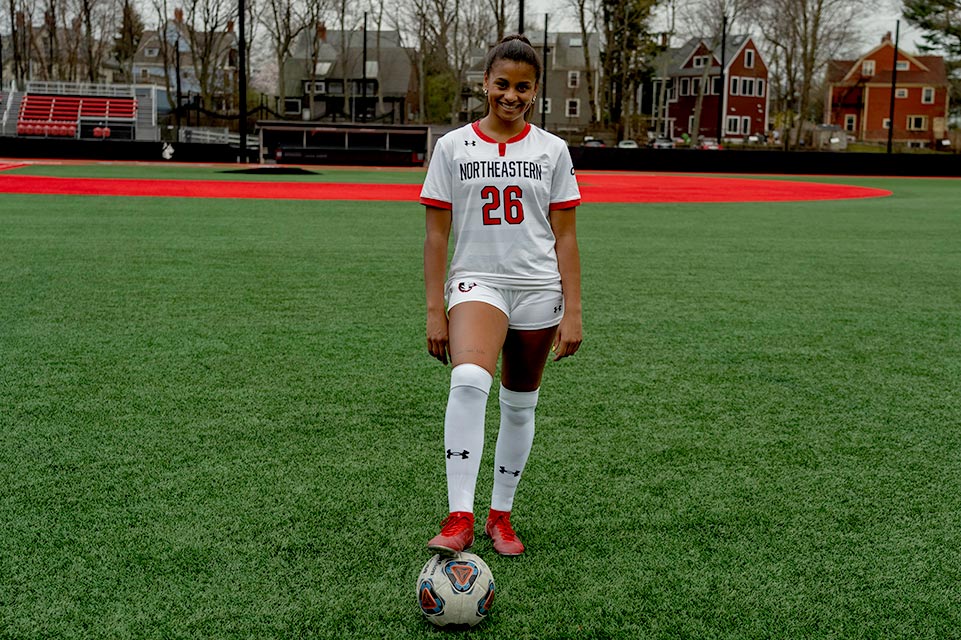Sports Medicine Physicians Explain How to Kick Injury Risks During FIFA World Cup

National Patient Ambassador Katherine on the soccer pitch.
The most popular team sport in the world is taking over the airways and fans from around the world are cheering on their home teams in the 2022 FIFA World Cup Qatar 2022! Many of those fans are young soccer athletes attempting to reenact the swift moves of Christin Pulisic, Cristiano Ronaldo and Lionel Messi on the soccer field, themselves. Shriners Children’s sports medicine physicians and orthopedic surgeons are encouraging young athletes, with help from parents and coaches, to follow a few simple steps and reduce their risk of injury for any sport, including soccer!
Preventing Injuries
Our physicians shared the following injury prevention tips and tricks to keep young athletes healthy on the field:
Make a schedule: “Make a calendar of daily and weekly athletic goals,” said sports medicine and orthopedic surgeon at Shriners Hospitals for Children — Canada Marie-Lyne Nault, M.D. “Follow the 10% rule: Increase activity by no more than 10% per week. This applies to the intensity, volume, distance and duration of workouts. Make time for rest and recovery after strenuous workouts. Don’t forget to give your body adequate nutrition and sleep.”
Stretch it out: “Consider adding stretching and yoga to your routine,” said medical director of sports medicine at Shriners Children’s Northern California Nicole Friel, M.D. “Professional athletes understand the benefits of stretching and yoga, and so should young athletes. With online resources and tutorials, yoga and stretching exercises are more accessible than ever before. Don’t forget to add stretching to your warm-up and your cool-down as well.”
Get creative: "Find and discover effective substitute exercises at home,” said orthopedic surgeon at Shriners Children’s Shreveport Patrick Massey, M.D. “Body weight exercises such as burpees, mountain climbers and jumping lunges are effective exercises. These three simple movements can improve cardio, strength and balance while working out in small spaces. Use soup cans or water jugs for weight training. Use a large couch cushion for lower extremity balance, proprioception and strengthening exercises in lieu of a half balance ball, also known as a Bosu ball or Dome ball.”
Diversify your activities: “Make sure your exercises and activities go beyond your sports specialization,” said orthopedic surgeon Gregory Kalv, M.D. “If you’re a pitcher seeking to remain at a high level of throwing, your workouts during this time should not be solely focused on pitching. In fact, most of your training should be directed towards reinforcing the basic mechanics of throwing and addressing any kinetic chain deficits. Consider adding in additional activities like walking, jogging or biking to your routine. Improving your core strength, lower extremity balance, flexibility and cardiovascular endurance are all ways to enhance your pitching capability. This applies to all repetitive activities that are at high risk for overuse injuries. Now is a great time to incorporate injury prevention programs like FIFA 11+ and follow guidelines from organizations like USA Baseball and their Pitch Smart program.”
Listen to your body: “Parents and coaches should encourage adequate sleep, nutrition and hydration to their young athletes, and should also ask about any pain, soreness or tightness, specifically when changes in sports performance are observed,” said physical medicine and rehabilitation physician at Shriners Children’s New England Julio Martinez-Silvestrini, M.D. “Parents and coaches should be on the lookout for any changes in athletic performance, like limping on a runner, or loss of control and speed on a throwing athlete, which may be a sign of injury. Some children may want to work extra hard to impress their coaches or make up for lost time. Encouraging them to be aware of their bodies and take note of how they feel is important. Early intervention with a timely medical evaluation, targeted conditioning exercises or even physical therapy will be key to avoiding further injury. Any young athlete which persists with pain, discomfort or difficulty performing their sports for longer than 1-2 weeks should seek medical attention.”
Parents and coaches can ensure that young athletes are reducing the risk for injury in competitive sports by making sure players ease into competitive training and play. Taking the time to ease back into full activity, following a schedule for a safe return to play and building up their core strength before resuming competitive sports are all effective ways to reduce a young athlete's risk of injury.
Keep In Touch
Join our mailing list to stay up to date on everything that's happening at Shriners Children's.





